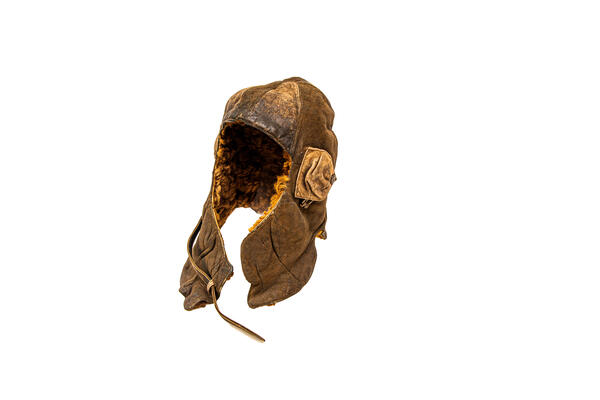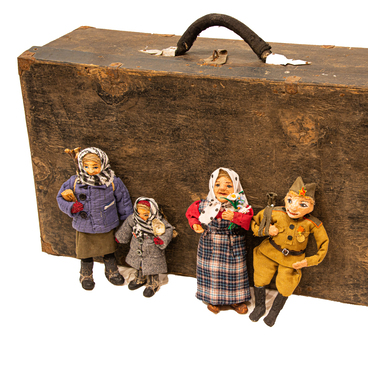Wartime headsets (in Russian — shlemofon — a helmet with a built-in radio) protected the Red Army soldiers from head injuries and noise, and were used as communication aids. The crews of combat and special vehicles, pilots, technical engineers, and sailors used them at their posts.
During the Great Patriotic War, the Soviet pilots had several types of headsets available — local or foreign made. Among them were the very popular German models with mesh tops, as well as American and English helmets that came from the United States under Lend-Lease Act, the state program of supplying military aid to foreign allies during World War II. As a result, when the development of a new flight helmet began in the USSR at the end of the 1940s, the designers took these foreign samples as a starting point.
The Museum of Military Glory houses the winter helmet of Soviet Union Hero Sergei Zakharov, which was donated to the museum after his death. It is a soft leather helmet with an insulated lining. Usually, it was equipped with flight goggles and an oxygen mask.
Sergey Zakharov was born on October 6, 1918, and was the third child in a family of peasants from the village of Kukishevo, Moscow region. From 1938 to 1946, he served in the Soviet Army. In 1938, the Kolomna military recruiting office sent Zakharov to the Borisoglebsk military school of pilots.
On November 30, 1939, the First Soviet-Finnish War began. At its final stage, in 1940, Zakharov fought as part of the 45th High-speed Bomber Aviation Regiment (SBAP). The pilot flew combat missions in the daytime.
In 1941, Zakharov became a student of the second Higher School of Navigators of Night Crews in Ivanovo. Here, he retrained to fly long-range bombers. It was a night monoplane — an aircraft with a single pair of wings, which was developed by a Soviet aircraft designer Sergei Ilyushin. In March 1942, Zakharov, along with other graduates, was sent to the front as part of the newly established 752nd Long-range Aviation Regiment of the 24th Long-range Aviation Division.
In April 1942, Zakharov made 25 training flights, and on the night of May 1, his first combat flight took place. At the very beginning of his flight, the speed indicator failed. But with an experienced navigator Leonty Glushenko, Zakharov managed to bring the plane to the specified target and destroy trains filled with equipment and German soldiers at the railway junction of the city of Orel.
On April 18, 1943, the crew flew to take part in the bombing of Konigsberg. Later, on April 25, for the successful execution of this combat operation, the Presidium of the Supreme Soviet awarded Zakharov the title of the Hero of the Soviet Union with the following words ‘for the heroic feat demonstrated during the execution of combat missions of the Command fighting at the front against the German invaders’.
During the Great Patriotic War, the Soviet pilots had several types of headsets available — local or foreign made. Among them were the very popular German models with mesh tops, as well as American and English helmets that came from the United States under Lend-Lease Act, the state program of supplying military aid to foreign allies during World War II. As a result, when the development of a new flight helmet began in the USSR at the end of the 1940s, the designers took these foreign samples as a starting point.
The Museum of Military Glory houses the winter helmet of Soviet Union Hero Sergei Zakharov, which was donated to the museum after his death. It is a soft leather helmet with an insulated lining. Usually, it was equipped with flight goggles and an oxygen mask.
Sergey Zakharov was born on October 6, 1918, and was the third child in a family of peasants from the village of Kukishevo, Moscow region. From 1938 to 1946, he served in the Soviet Army. In 1938, the Kolomna military recruiting office sent Zakharov to the Borisoglebsk military school of pilots.
On November 30, 1939, the First Soviet-Finnish War began. At its final stage, in 1940, Zakharov fought as part of the 45th High-speed Bomber Aviation Regiment (SBAP). The pilot flew combat missions in the daytime.
In 1941, Zakharov became a student of the second Higher School of Navigators of Night Crews in Ivanovo. Here, he retrained to fly long-range bombers. It was a night monoplane — an aircraft with a single pair of wings, which was developed by a Soviet aircraft designer Sergei Ilyushin. In March 1942, Zakharov, along with other graduates, was sent to the front as part of the newly established 752nd Long-range Aviation Regiment of the 24th Long-range Aviation Division.
In April 1942, Zakharov made 25 training flights, and on the night of May 1, his first combat flight took place. At the very beginning of his flight, the speed indicator failed. But with an experienced navigator Leonty Glushenko, Zakharov managed to bring the plane to the specified target and destroy trains filled with equipment and German soldiers at the railway junction of the city of Orel.
On April 18, 1943, the crew flew to take part in the bombing of Konigsberg. Later, on April 25, for the successful execution of this combat operation, the Presidium of the Supreme Soviet awarded Zakharov the title of the Hero of the Soviet Union with the following words ‘for the heroic feat demonstrated during the execution of combat missions of the Command fighting at the front against the German invaders’.



